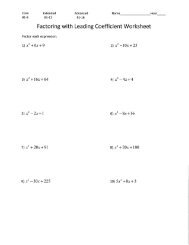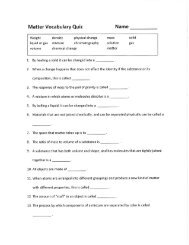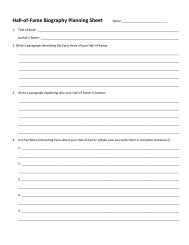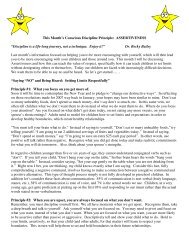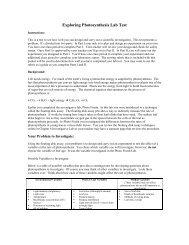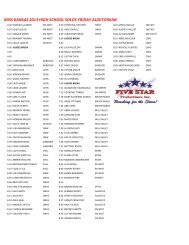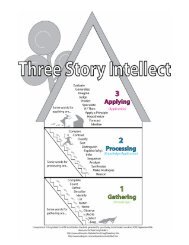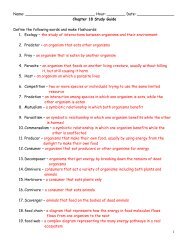Figurative Language
Figurative Language
Figurative Language
Create successful ePaper yourself
Turn your PDF publications into a flip-book with our unique Google optimized e-Paper software.
<strong>Figurative</strong><br />
<strong>Language</strong>
Sometimes writers use figurative language<br />
to create vivid descriptions. <strong>Figurative</strong><br />
language is the use of words in ways apart<br />
from their ordinary meanings. The words<br />
or phrases do not mean exactly, or literally,<br />
what they say, instead, they create<br />
impressions by suggesting comparisons,<br />
unlikely actions, or exaggerations that<br />
make the reader take notice.
• Here are some examples of figurative language:<br />
– The snow on the lawn was like frosting on a cake.<br />
– The snow on the lawn was a thick, white frosting.<br />
– The snow tucked a white blanket over the lawn.<br />
– The snow on the lawn was piled in mountain-high<br />
drifts.<br />
– The first two sentences help us see the snow as white frosting.<br />
– The third sentence creates the sense of the snow placing a white<br />
blanket on the lawn,<br />
– and the last sentence makes us see lots of snow in high drifts.
Types of figurative<br />
language include similes,<br />
metaphors, personification<br />
and hyperbole.
The snow on the lawn was like<br />
frosting on a cake.<br />
This is an example of a simile.<br />
A simile is a statement comparing things<br />
using the words like or as. A simile tells<br />
us what something is like. In this sentence<br />
the snow was like frosting.
The snow on the lawn was a thick,<br />
white frosting.<br />
• This sentence is a metaphor.<br />
• A metaphor is a statement comparing<br />
things. A metaphor says that one thing is<br />
another thing. It does not use like or as.<br />
• In the second sentence, the snow was<br />
frosting.
The snow tucked a white<br />
blanket over the lawn<br />
• This sentence is an example of<br />
personification.<br />
• Personification is a statement that gives<br />
human traits or actions to a nonliving thing.<br />
• In this sentence, the snow tucked a blanket<br />
over the lawn.
The snow on the lawn was piled<br />
in mountain-high drifts.<br />
• This sentence is an example of hyperbole.<br />
• Hyperbole is a statement of exaggeration.<br />
In this sentence, the snow was piled in<br />
mountain-high drifts.
Mackenzie was as tired-looking as<br />
wilted lettuce.<br />
• This is an example of<br />
a. simile b. metaphor<br />
c. personification d. hyperbole<br />
What is the literal meaning<br />
Mackenzie was really tired.
Wilbur was a library of information.<br />
• This sentence is an examples of<br />
a. Simile b. metaphor<br />
c. Personification d. hyperbole<br />
The literal meaning of this sentence is:<br />
Wilbur knew a lot.
The tree roots slurped up the heavy<br />
rain.<br />
• This sentence is an example of<br />
• a. simile b. metaphor<br />
• c. personification d. hyperbole<br />
• What is the literal meaning<br />
• The tree needed rain.
Our cat, Jinx, ruled the entire<br />
household.<br />
• This is an example of:<br />
• a. simile b. metaphor<br />
• c. personification d. hyperbole<br />
• What is the literal meaning<br />
• Jinx got his own way.
You could see the traffic for miles ahead.<br />
Every few minutes the cars would move a<br />
couple of feet, then come to a halt. “This<br />
is awful!” wept Andrea. “We’ll never get<br />
home. The cars are lined up all the way to<br />
the West Coast!”<br />
The figure of speech used in this paragraph is<br />
a. simile b. metaphor c. personification d. hyperbole<br />
What did she really mean
The Chinese New Year lasts for fifteen days and is observed by<br />
Chinese communities the world over. During this time, many special<br />
traditions are followed. One is the popular Dragon Dance, when<br />
people in a dragon costume twist and prance through the streets.<br />
On the last day of the New Year, when the full moon rises, the<br />
Chinese celebrate the Lantern Festival. Thousands of paper and silk<br />
lanterns twinkle in the dark like magic stars. This happy night<br />
embraces the New Year.<br />
This shows an example of<br />
a. simile b. metaphor c. personification d. hyperbole<br />
It compares ___________ to ______________.<br />
Find another example of figurative language<br />
in the paragraph above.
• The camera spoke for him. I the 1920’s and 30’s James Van DerZee<br />
photographed the people and events in Harlem, a part of New York City. At<br />
that time, Harlem was home to talented black entertainers, artists, poets,<br />
athletes, writers, and politicians. People from all over went to Harlem to<br />
enjoy its music, theaters, and nightspots. Van DerZee captured both the<br />
famous and the ordinary on film. Many years later, Van DerZee’s work was<br />
exhibited at an important museum. His photos welcomed people into the<br />
past.<br />
• These words are an example of<br />
a. simile b. metaphor c. personification d. hyperbole<br />
The words suggest ____________________________.<br />
Find another example of figurative language<br />
in this paragraph. What is it called
A shoe by the side of the road is an untold story.<br />
Where is the mate How did it get there Many people<br />
are curious about shoes lying on the sides of roads.<br />
They have come up with several explanations. One<br />
idea is that the shoes were tossed out of cars by<br />
children during arguments. Another idea is that hikers<br />
accidentally dropped a shoe. A third theory is that the<br />
shoes fell out of garbage trucks. No one knows for<br />
sure. These single roadside shoes don’t tell their<br />
secret.<br />
This is an example of<br />
a. simile b. metaphor c. personification d. hyperbole<br />
It compares ___________ to ___________.<br />
Find another example of figurative language.






